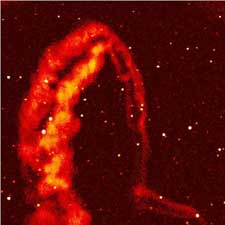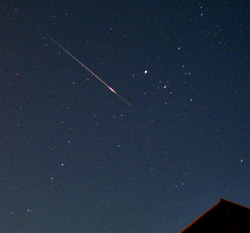
The only train acquired by the Starfire Optical Range during the 2002 Leonid meteor shower was this striking smoky cloud dubbed 'the Arch.'
Courtesy Scott Milster and the Air Force Research Laboratory, Directed Energy Directorate, Starfire Optical Range.
When the Leonid meteor shower peaked on the morning of November 19th, bits of debris from Comet Tempel-Tuttle came shooting into Earth's atmosphere at a speed of 71 kilometers per second. The result was a fine shooting-star show that will remembered for years to come. But what makes the Leonids unique is that an unusual number of them leave lingering trains in their wake — snaking white glows that can last from a second up to 20 minutes.
Jack D. Drummond (Starfire Optical Range) and a team of astronomers have been analyzing these trains since 1998. What he's gathered shows us just how mysterious this phenomeon is.
Drummond's group rapidly slewed a 3.5-meter telescope at the Air Force Research Laboratory in Albuquerque, New Mexico, to a train, then illuminates it with pulses of light from a powerful sodium laser. The team uses the laser beam as a form of radar, or "lidar," which stands for light detection and ranging.
Not much is known about the lingering marks meteors make. Scientists think the trains are created by chemiluminescent reactions, which come from the catalytic conversion of sodium molecules and O3. The initial friction between the meteor and the atmosphere strips sodium atoms of electrons. This leaves a sea of electrons that recombine with oxygen atoms and emit light in the process. Drummond's team speculates that most of the light from the train comes from this process.
In order to seek more answers, Drummond's team paired with one led by John Zinn at the Los Alamos National Laboratory in Los Alamos, New Mexico. The two groups are looking closely at computer simulations of meteors to narrow down the cause of the trains, says Drummond. "[A meteor] comes through the atmosphere so fast it is like an instantaneous explosion along a line," explains Drummond. "The trail expands rapidly and then just stops."

Norwegian amateur Jarle Aasland caught this 2002 Leonid streaking its way past the bright star Aldebaran, in Taurus at 4:57 UT on November 19th. He used a Nikon D100 (digital SLR) set to ISO 800 and a 5-second exposure.
Courtesy Jarle Aasland.
Although Drummond was able to study several trains in 1998 and 1999, his group caught only one this year, and it didn't turn up anything new. "However, that's just a preliminary conclusion," he notes.
As scientists delve deeper into the cause of these mysterious trains, there remain several unanswered questions. One mystery is why meteors occasionally create parallel trains, which were previously attributed to a phenomenon known as shell burning. Drummond's group has since disproved the theory, though they cannot yet explain the parallel trails. Another question is: Why the Leonids? Although the Perseids sometimes have trains, they leave far fewer than Leonids do.
Unfortunately, scientists will have to find their answers to these questions from the data they have on hand. The next strong Leonid shower should come in 2098.
 0
0
Comments
You must be logged in to post a comment.